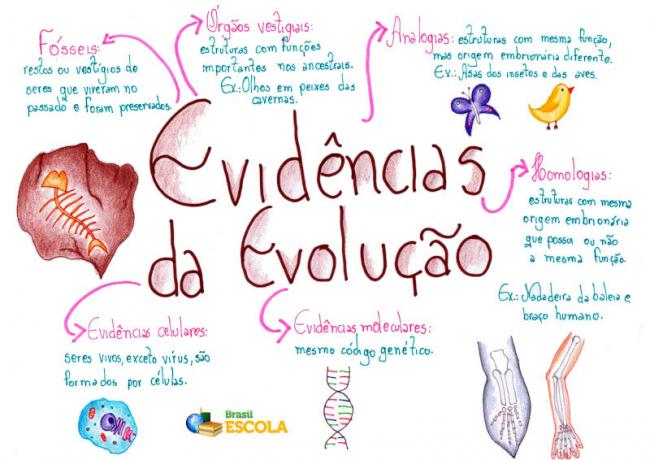In the scientific world, hypotheses are developed as answers to certain questions about a specific phenomenon. When a hypothesis is confirmed several times, by experimentation and/or a body of evidence, it has a good chance of becoming a theory.
Thus, the Theory of Evolution brings together a series of evidences and proofs that make it irrefutable to date:
The first evidence refers to the fossil records, being consistent proof that our planet once harbored different species than those that exist today. These records are strong evidence of evolution because they can provide us with clues to kinship. between these and current living beings as we observe, in many cases, a continuous modification of the species.
THE adaptation, ability of the living being to adjust to the environment, can be another evidence, since, by natural selection, individuals with certain advantageous characteristics - such as the color similar to that of its substrate - are more likely to survive and transmit to their descendants such characteristics. Thus, over the generations, certain characteristics change, becoming more and more efficient. Examples of adaptation by natural selection are camouflage and mimicry.
Mind Map: Evidence of Evolution

* To download the mind map in PDF, Click here!
At analogies and homologies can also be considered as evidence of evolution based on morphological and functional aspects, since the study comparative analysis of the anatomy of organisms shows the existence of a similar fundamental pattern in the structure of systems of organs.
Analogous Structures perform the same function, but have different origins, such as the wings of insects and wings of birds. These, despite playing similar roles, are not derived from the same structures present in an exclusive common ancestor between these two species. Thus, the evolutionary adaptation to similar ways of life leads little-related organisms to develop similar forms, a phenomenon called convergent evolution.
homology refers to body structures or organs that have a similar embryonic origin, and may perform the same function (whale's fin and fin of a dolphin) or different functions, like the wings of a bat and the arms of a human, and the pectoral fins of a dolphin and the wings of a a bird. This adaptation to different ways of life is called divergent evolution.
You vestigial organs - poorly developed structures and without expressive function in the organism, such as the vermiform appendix and the cocciis - may indicate that these organs were important in our remote ancestors and, as they ceased to be advantageous throughout evolution, they regressed during this process. These organs can also be present in certain species and absent in others, even though both exist in the same period.
One last piece of evidence, the molecular evidence, shows us the similarity in the molecular structure of several organisms, and the greater the similarities between the sequences of nitrogenous bases of nucleic acids or the greater the similarity between the proteins of these species, the greater the relationship and, therefore, the evolutionary proximity between the species.
* Mind Map by Ma. Vanessa dos Santos
By Mariana Araguaia
Source: Brazil School - https://brasilescola.uol.com.br/biologia/evidencias-evolucao-biologica.htm

